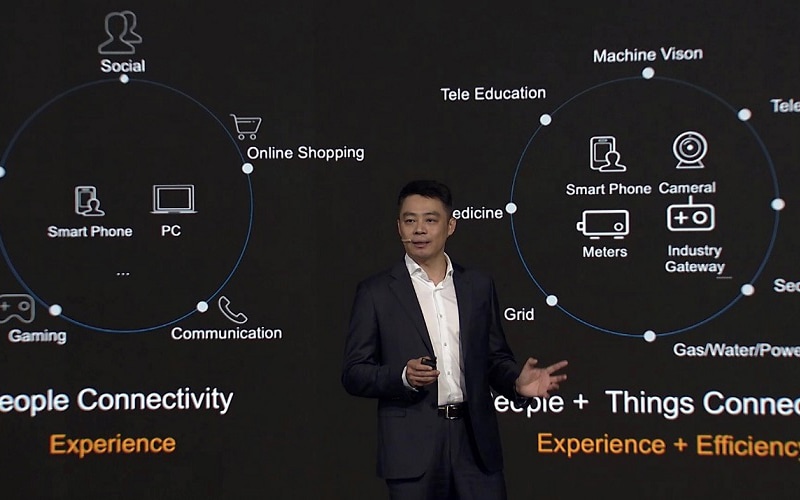[Shenzhen, China, July 28, 2020] At the Better World Summit 2020 hosted online by Huawei, Ritchie Peng, President of Huawei’s 5G Product Line, delivered a keynote speech titled “5G Brings New Value to Industries.”
In his speech, Mr. Peng elaborated that “5G is the foundation of industrial digitalization. Established on unified infrastructure, it provides end-to-end (E2E) slicing and enhanced network capabilities to fulfill the requirements of various industrial use cases while also advancing the development of AI, cloud, computing, and applications. 5G helps industries to improve energy efficiency, generate new value, and achieve new growth.”
 Ritchie Peng delivers a keynote speech
Ritchie Peng delivers a keynote speech
Enabling a natural fusion with industries, 5G expands people-centered digital connections to scenarios requiring the connections of things. This will lead to four significant changes.
Diverse network services: In addition to common mobile Internet access, 5G networks provide connections to both homes and industries, enabling various industrial applications, such as wireless HD live streaming, telemedicine, remote control, and smart manufacturing.
Comprehensive capabilities: While delivering a higher downlink bandwidth, 5G networks will also ensure a higher uplink bandwidth, low-latency transmission, and greater robustness, particularly for industrial applications, in addition to high-precision positioning and other new capabilities.
Various terminals: Today, smartphones operate as mainstream terminals for both 3G and 4G networks. As 5G begins to take center stage, a wider spectrum of devices will also gain access to networks, such as customer-premises equipment (CPE), cameras, and unmanned aerial vehicles (UAVs).
Greater connection value: Being both people-centered and things-oriented, 5G connections will not only provide excellent user experiences, but also enable industries to optimize production modes for higher energy efficiency and improved working environments, while also delivering on the commitment to sustainable development.
Diverse Network Services Based on Unified 5G Architecture
The 3rd Generation Partnership Project (3GPP) has developed an E2E slicing architecture across radio networks, core networks, and terminals. Slices can be automatically created, managed, and operated on the network side, enabling the multiplexing of virtual networks on the same network infrastructure. Each slice is an isolated E2E network tailored to fulfill the diverse requirements of various industrial applications.
3GPP Release 15 has already been commercialized, with a strong focus on bandwidth-hungry services, such as HD live streaming, telemedicine, and public safety. A newly finalized version of 5G specifications — 3GPP Release 16 — supplements 5G capabilities with comprehensive support for ultra-reliable low-latency communication (URLLC) applications. This will inject fresh momentum towards the development of applications requested by industrial users to reduce costs and improve efficiency, providing carriers with new opportunities to generate market growth.
Rapid Device Development and a Maturing Ecosystem
Based on the latest survey by the Global mobile Suppliers Association (GSA), 49 5G-capable modules have already been launched, over 54% of which will be commercially adopted by the end of 2020. As 5G modules continue to grow, an increasing diverse range of 5G devices will appear on the market, including industrial CPEs, 5G set -top boxes (STBs), and vehicle-tailored 5G terminals T-Boxes.
Today, 5G industrial CPEs are already being utilized to support the remote operation of machinery in ports, while 5G cameras are adopted to implement live broadcast throughout the recent mission to measure the height of Mount Qomolangma, more commonly known as Mount Everest. Two to three million 5G modules are expected to on the market in China, and as a large market scale is conducive to a significant cost decrease, individual prices are projected to be as low as USD 20 by 2021. Such a low barrier to entry will serve to drive the development of industrial applications.
5G-Powered Industrial Digitalization Cultivates New Value
5G offers a tremendous opportunity for mobile networks to improve efficiency and create new value throughout vertical industries, and the integration of 5G with vertical use cases has already generated many success stories.
In smart ports, 5G’s high bandwidth and low-latency transmission are kicking off a revolution in crane operations, characterized by a shift from onsite operations to remote control and the remarkable reduction of business costs. Whereas traditional onsite operations allow one operator to operate only one crane, remote control enables every operator to control four cranes concurrently. In addition to a 70% reduction of labor costs, this technology increases the cargo handling capacity from 25 to 30 containers per hour and greatly improves the working environment to minimize safety risks.
5G has also been successful in increasing energy efficiency and reducing energy consumption and emissions, thereby supporting sustainable social development. 5G modules offer a capacity 50 times larger than their 4G counterparts, while still consuming a similar amount of energy. As a result, the per-bit energy efficiency becomes 50 times higher.
5G enables higher energy efficiency through optimized industrial production. In one case of healthcare services, 5G enables the implementation of remote consultancy, reducing regular face-to-face doctor visits of four doctors without scaling down the number of patients or compromising the diagnosis quality. Thanks to fewer physical journeys, greenhouse gas emissions associated with the traditional face-to-face services of these doctors are cut by 99.6%.
5G-Driven Innovation and Collaboration Boosts Industry Value
Mr. Peng underlined the significance of technological innovation and the continuous enhancement of 5G networks in expanding their applications across various vertical industries. For example, TDD networks are primarily introduced to fulfill enhanced Mobile Broadband (eMBB) requirements, leading them to perform far better in the downlink than it does in the uplink. Inevitably, this approach will fail to satisfy the requirements for high-bandwidth and low-latency uplink transfer as 5G continues to drive industrial digitalization.
To address this problem, Huawei has launched the innovative Super Uplink solution together with industry partners. This E2E solution enables complementary utilization of the TDD and FDD spectrum to improve uplink performance while reducing latency. To date, this innovation has been adapted on both the radio access and core networks, and the verifications completed on live networks demonstrate a 30% decrease in latency and a fourfold increase in uplink speeds. Combined with full-uplink frequency bands, TDD systems will be able to deliver a Gbps uplink experience.
While stressing technological innovation, Mr. Peng called on the industry to “work closely to delve into business models, standards, policy support, application innovation, and device diversification, as this is vital to the growth of industrial applications and the creation of new industry value.”

For more information about Better World Summit 2020, click here.
PR Archives: Latest, By Company, By Date